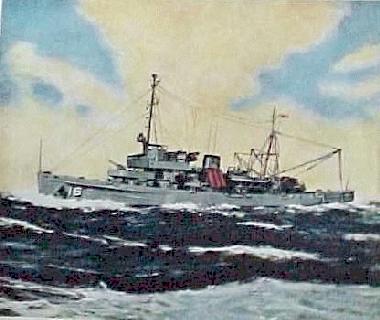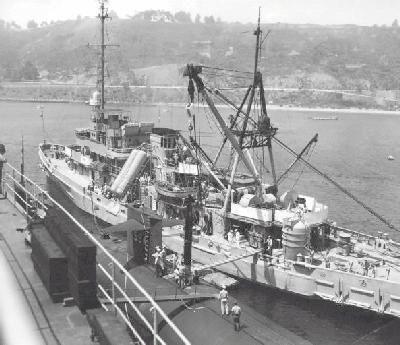


|
|
Guardians of the Submarines
For most of this (20th) century, when submarines have gone to sea to conduct sea trials, they have been accompanied by a small ship with an important mission. The auxiliary submarine rescue (ASR) ship escorted the submarine, standing by in case of an emergency. The ASR acted as a safety vessel, patrolling the area to warn ships to keep clear of the submarine operating area, and recovered practice torpedoes fired by the submarine. Divers stood ready on board the ASR to perform submarine rescue duties in the event of an accident. Since there was no international flag signal early in the century for this type of operation, the black fish insignia was displayed by all ASRs. Thus ASRs took up the role as "guardians of the submarines," and eventually were formally authorized to display the distinctive black fish insignia beside their hull numbers as a tribute to their mission. Submarine rescue ships have enjoyed a long and proud history in the U.S. Navy. The need for these vessels was driven home early in the century by the tragic loss of the submarines S-51 and S-4 in 1925 and 1927. The exploits of two of the most famous submarine rescue ships serve as a testament to the dedication and bravery of the crews manning the fleet of little ships marked by the distinctive black fish insignia. In May of 1939 the submarine SQUALUS sank in 243 fsw when its main induction valve failed to close. The submarine rescue ship FALCON, a veteran of the salvages of the S-51 and S-4, arrived on scene the following day. Through the extraordinary efforts of crew of the FALCON, 33 men were rescued from the SQUALUS using with the submarine rescue chamber and MK-5 Deep Sea Diving Gear. Later in the year, FALCON lead the salvage effort to raise the SQUALUS. SQUALUS was subsequently refitted and recommissioned as the USS SAILFISH and went on to serve proudly in World War II. Not all submarine rescue efforts have been confined to sunken submarines. On December 10, 1941, three days after Pearl Harbor, Japanese aircraft savagely attacked Cavite Navy Yard in Manila Bay, Philippines. On that day USS PIGEON (ASR 6) was moored in a five-ship nest at Cavite Yard. PIGEON was then under the command of Commander "Spittin' Dick Hawes" a veteran of the S-51 and S-4 salvage operations, a former Master Diver, and previous CO of USS FALCON. The PIGEON had been permanently assigned to the Asiatic Fleet since 1923. She was a veteran of the "China Fleet" and the famous Yangtze River Patrols. In the hail storm of falling bombs and with Cavite Navy Yard already ablaze, PIGEON cleared the nest with the minesweeper QUAIL still made up alongside. After maneuvering clear and freeing QUAIL, she then turned back to aid the submarines SEALION and SEADRAGON, the BITTERN, another minesweeper, and a gasoline tender still trapped alongside the pier. SEALION already lay with its pressure hull holed, damaged beyond repair. The flames and explosions from the torpedo warhead shop on the pier were showering the trapped vessels in a firestorm of missiles and debris. With paint blistering on her hull, PIGEON moved in, passing a tow line to the damaged and powerless SEADRAGON, and hauled her off the pier to safety. As PIGEON worked SEADRAGON into open waters, CDR Hawes dispatched ship's boats to bring BITTERN and the gasoline tender to safety. PIGEON's work boats were successful in saving them from being engulfed in the inferno. PIGEON was awarded the first Presidential Unit Citation ever awarded to a U.S. Navy ship for her actions that day. SEADRAGON was repaired by the submarine tender CANOPUS and was back at sea December 16, 1941, going on the attack and becoming one of the tonnage champions in Pacific Theater during World War II. As the war progressed the Allied Forces in Philippines were ultimately cut off and overrun. The PIGEON stayed behind, along with the submarine tender CANOPUS, and continued her noble defense of the Philippines and Corregidor. CANOPUS was scuttled April 9, 1942 to prevent her from falling into enemy hands. PIGEON held out for almost another month, but was finally sunk by a Japanese dive bomber on May 4, 1942. PIGEON was awarded a second Presidential Unit Citation and a Battle Star for her determined struggle. The bulk of PIGEON's valiant crew were eventually captured by the Japanese and interned at the infamous prisoner of war camp at Cabanatuan, Philippines. The last U.S. Navy auxiliary submarine rescue ship, the USS ORTOLAN (ASR-22) was decommissioned in March 1995, thus ending the illustrious era of the auxiliary ships that displayed the distinctive black fish insignia and proudly stood by during most of this century as guardians of the submarines. The mission of submarine rescue is carried on by elements of Commander Submarine Development Group One, including the Deep Submergence Rescue Vehicles (DSRV) MYSTIC and AVALON and the U.S. Navy divers manning the fly-away submarine rescue chambers at the Deep Submergence Unit, at North Island Naval Air Station, San Diego CA. (See NOTE: 2) Food for thought: If suddenly faced with a sunken submarine disaster, are you ready to answer that call as a Navy diver? If you are training hard and maintaining your qualifications, the answer is yes; if you're not, get busy! When it happens, you won't have time to prepare for the diving work that may have to be done. CDR Dale Lueck is the U.S. Navy Supervisor of Diving and former crew member of USS PIGEON (ASR 21), the third U.S. Navy ship to bear that name. |
| Posting Date: April 2002
NOTE: 1 INFO FROM: http://www.globalsecurity.org/military/systems/ship/asr-21.htm No new ASRs are included in the Navy's long range shipbuilding plans.
INFO FROM http://www.csp.navy.mil/csds5/index.htm Submarine Development Squadron Five was established in 1967, originally as Submarine Development Group ONE, as the operational focal point for Navy Deep Submergence, Submarine Rescue, Ocean Engineering and Research and Development Programs. Responsible for long-range deep submergence planning and the identification of new military requirements, Development Squadron 5 maintains a liaison with this country’s top scientific, technical and oceanographic talent. In addition, Development Squadron 5 conducts cooperative programs with civilian scientific and academic institutions in pursuit of national science objectives. Responsible within the submarine force for tactical development in the areas of escape, rescue, diving, unmanned underwater vehicles, Naval Special Warfare, and Arctic operability. This includes developing and testing new tactics and systems for incorporation and dissemination within the submarine force. |
|
|